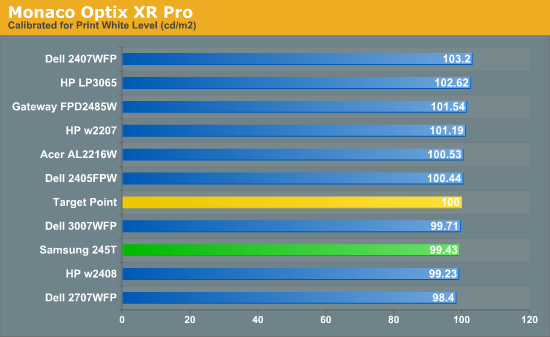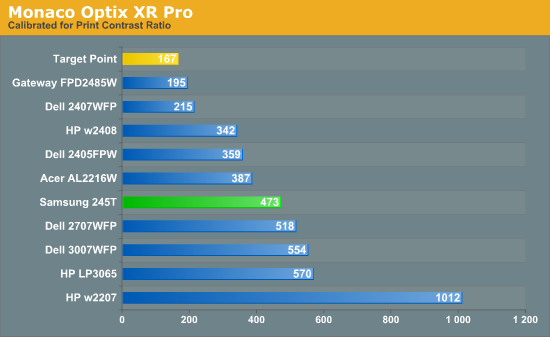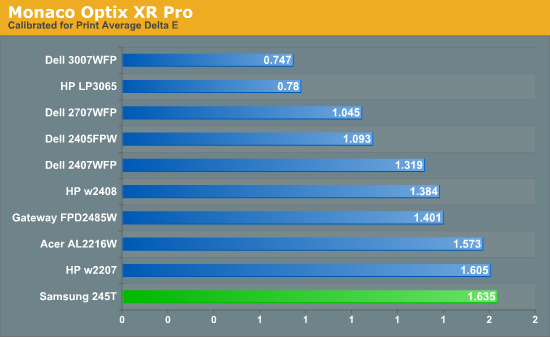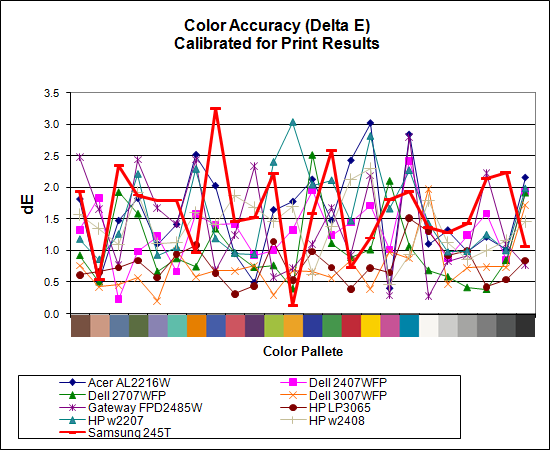Printing
Results
Brightness and Contrast Ratio
For those who have a need to match colors between their computer displays, cameras, and printers, what works well for computing purposes often isn't the best suited for doing other image related work. To help people who work in such areas match their computer colors to their paper colors better, standards were established. For print work, the standard is a gamma of 2.2, a black point of 0.60 nits, and a white point of 100 nits. We attempt to calibrate all the monitors for these settings.
Finding the appropriate settings to reach these levels can be a time-consuming process for some of the displays. It may require numerous iterations through the calibration process to end up with the desired white point, and on some LCDs it might not even be possible to reach a satisfactory result (though that hasn't occurred yet). The nature of LCDs is such that we are unable to get both an accurate white point and an accurate black point according to printing requirements (our black levels always ended up darker than they are supposed to be), but we did manage to get near the desired 100 nits white point on all of the tested displays. For the Samsung 245T, we used brightness/contrast settings of 13/75, with RGB at 16/21/36. We tried several other settings, but all others scored worse so we settled on these values.
For reference, we have included the target value in the following graphs, so the greater the deviance of a display from the targeted value, the less suitable (in theory) a display becomes for print work.



Since very slight differences in brightness are not a huge deal, we did not attempt to get 100% accuracy on the white point, but further tuning of the various displays would have made it possible to get closer to 100 nits. The primary goal was to get the white point near 100 nits. The target black point is impossible to achieve once we have reached the target white point with any LCD that we have tested to date - and we expect that trend to continue. Due to the reduced brightness, contrast ratios are often lower, but that is inherent with the target settings. The Samsung 245T is pretty average when it comes to "calibrate for print" brightness and contrast ratio.
Color Accuracy
Given the importance of accurate colors for printing work, we need to adjust the desired Delta E scale. A Delta E of less than 1.0 is definitely the goal here, and 1.0 to 2.0 is merely acceptable. Scores above 2.0 generally mean a display is not fit for printing professionals.


At the reduced brightness setting used in this test, the Samsung 245T doesn't score as well as it does in other areas. In fact, it's technically the worst LCD we've tested so far -- at least in terms of raw score -- when it comes to calibrating the display for print work. Considering that all of the displays do reasonably well in this test, however, this probably isn't a big enough concern that we would strongly recommend a different display, other than one of the 30" LCDs on the market. Whether it's their use of S-IPS panels or something else, we can't say, but the 30" LCDs that we've tested have the lowest Delta E scores of any of the monitors.










60 Comments
View All Comments
Deusfaux - Thursday, February 7, 2008 - link
I thought Samsung monitors had a 16:9 scaling mode?JarredWalton - Thursday, February 7, 2008 - link
This one doesn't... other Samsung displays might. See the OSD image gallery for details. The only options are "Wide" (fill the whole screen) and "4:3". That means that 5:4 resolutions (1280x1024) will also be distorted no matter what you do. I don't think the minor stretch of 16:9 to 16:10 is terrible, but some people care more about that than I do. Again, though, this is only an issue on non-PC use (or if your drivers don't allow you to correct the scaling).hotdogandchips - Thursday, February 7, 2008 - link
Jarred, can you tell us when the NDA regarding the 2408WFP expires by any chance? ;0JarredWalton - Thursday, February 7, 2008 - link
LOL... actually, no, I can't. Funny thing is that the date isn't set in stone just yet either, which is part of the reason I can't say. It's supposed to be this month, based on what I heard at CES, but it might get moved to early March?AcAuroRa - Thursday, February 7, 2008 - link
According tohttp://www.samsung.com/us/system/consumer/product/...">http://www.samsung.com/us/system/consum.../C070096...
... its a TN.... bah I'm confused -_-.. is it a TN or a PVA?
I actually own a w2408... and I actually like the thing -_-;;...but if there can be some facts straightened out I might go and get a 245T off the 'Egg as it is currently on sale for $650...
JarredWalton - Thursday, February 7, 2008 - link
See above post... the unit I reviewed is most assuredly an S-PVA panel. I believe the PDF is simply erroneous.bobo51 - Thursday, February 7, 2008 - link
I am confused.The article identifies the 245T as having a PVA panel. But I just went to the Samsung website and in their specification PDF for the 245T the panel is stated to be a TN.
Is their website document incorrect?
JarredWalton - Thursday, February 7, 2008 - link
I can absolutely state that the 245T LCD I have is S-PVA (based on how it looks from various angles), and Samsung told me it was S-PVA before I received it. http://www.samsung.com/us/system/consumer/product/...">This states otherwise, so I guess someone just put the wrong information in there. The other possibility is that there are different LCD panels in some of the 245T displays... hopefully not.Most companies do not make a point of stating what sort of technology their panels use. While I can understand that on TN panels, I'd think anyone using a PVA or IPS panel would want to crow about it. Kudos to Samsung for at least putting information on all of their displays in the PDF files; now they just need to make sure the data is correct. :)
I'm going to email my Samsung contact about this and see if there's just an error in the PDF that they can correct.
XrayDoc - Thursday, February 7, 2008 - link
I was all excited about this new display until I read about the limited scaling choices. I can't believe they didn't include a 1:1 or pixel to pixel option! Not everyone has a triple SLI video card setup that can run Crysis well at 1920 x 1200. I'd much prefer to run the game at a lower resolution with black borders and have the "pixels" look sharp, as opposed to stretching the non native resolution to fill the screen and look blurry! Plus automatically stretching 16:9 aspect sources vertically to fill the 16:10 screen is just plain ludicrous. Most people can notice when the aspect ratio is displayed incorrectly. What happens with a 2.35:1 ratio DVD? Does that also get stretched vertically so that you dont' see any black bars at the top or bottom? This single design flaw is a definite deal breaker for me. I hope the upcoming new models from Dell, etc. don't have this same design flaw.yyrkoon - Friday, February 8, 2008 - link
The big question would be; 'why do you need a 24" LCD to play Crysis?' For me personally I cannot see the need for anything much more than a 19" LCD(a good one at that) for gaming. This making current title fly on my C2D system with a 7600GT, and it draws way less power than one of the current higher end cards. Granted I probably wouldnt mind using a 8600 or something that draws slightly more power, and has DirectX 10 capabilities, but I wont go out of my way just yet to purchase another card, especially since I am still using XP Pro.Also I'm noticing complaints about input lag ? I would think this would be an image retouching LCD which doesnt require fast screen refreshes. You can buy cheap fast LCDs that will play games just fine(all day long).